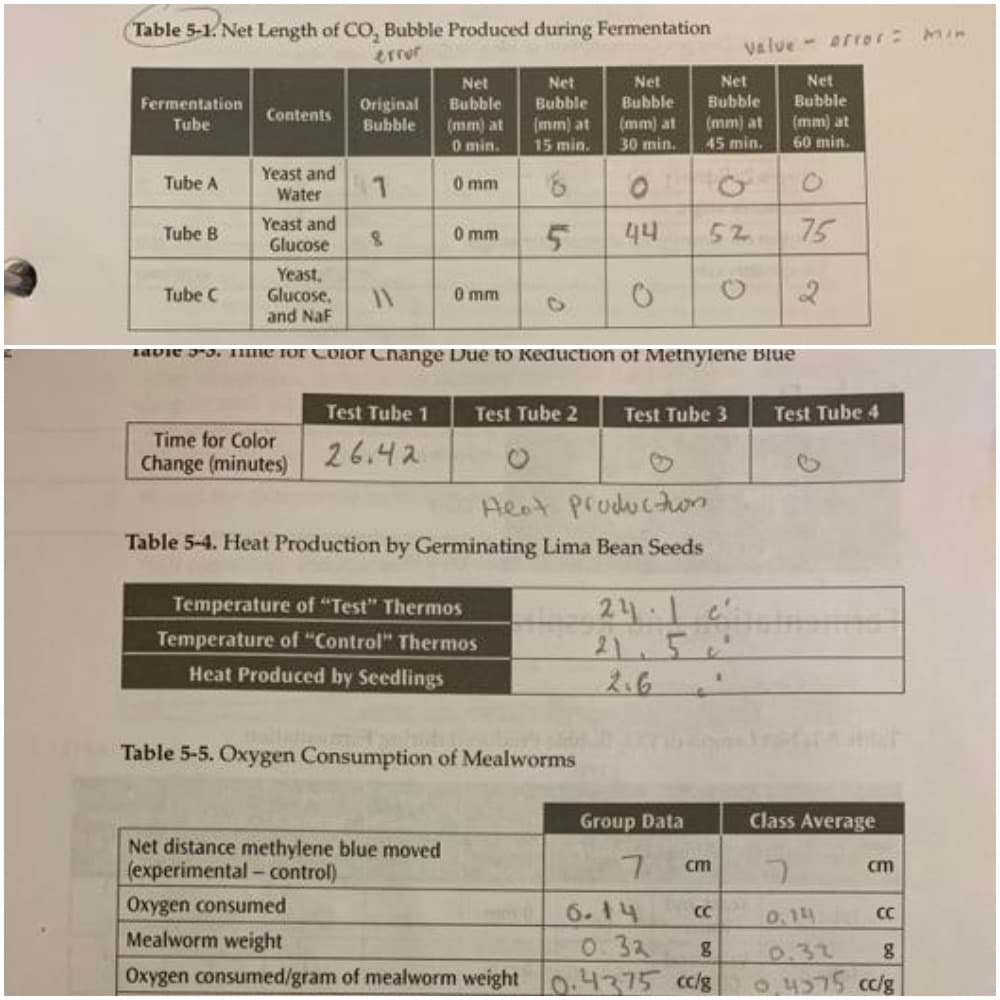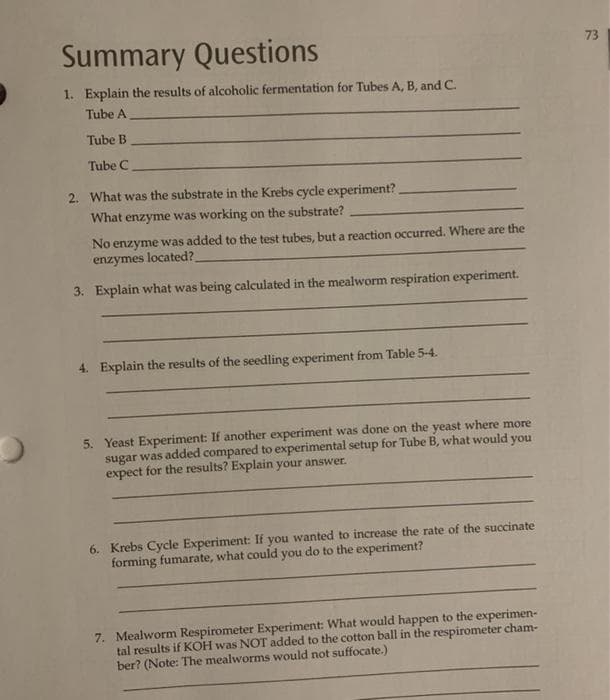Summary 1. Explain the results of alcoholic fermentation for Tubes A, B, and C. Tube A Tube B Tube C. 2. What was the substrate in the Krebs cycle experiment? What enzyme was working on the substrate? No enzyme was added to the test tubes, but a reaction occurred. Where are the enzymes located? 3. Explain what was being calculated in the mealworm respiration experiment.
Summary 1. Explain the results of alcoholic fermentation for Tubes A, B, and C. Tube A Tube B Tube C. 2. What was the substrate in the Krebs cycle experiment? What enzyme was working on the substrate? No enzyme was added to the test tubes, but a reaction occurred. Where are the enzymes located? 3. Explain what was being calculated in the mealworm respiration experiment.
Human Anatomy & Physiology (11th Edition)
11th Edition
ISBN:9780134580999
Author:Elaine N. Marieb, Katja N. Hoehn
Publisher:Elaine N. Marieb, Katja N. Hoehn
Chapter1: The Human Body: An Orientation
Section: Chapter Questions
Problem 1RQ: The correct sequence of levels forming the structural hierarchy is A. (a) organ, organ system,...
Related questions
Question
Plz do the Summary Questions

Transcribed Image Text:Table 5-1. Net Length of CO, Bubble Produced during Fermentation
value - error Min
error
Net
Net
Net
Net
Net
Bubble
(mm) at
60 min.
Fermentation
Bubble
Bubble
Bubble
Bubble
Original
Bubble
Contents
(mm) at
0 min.
(mm) at
15 min.
(mm) at
30 min.
(mm) at
45min.
Tube
Yeast and
Tube A
0 mm
Water
Yeast and
Glucose
44
52
75
Tube B
O mm
Yeast,
Glucose,
and NaF
Tube C
0 mm
TavIE PI. TITIE Tor COior Change Due to Reduction of Methylene Blue
Test Tube 1
Test Tube 2
Test Tube 3
Test Tube 4
Time for Color
Change (minutes)
26.42
Heat productuon
Table 5-4. Heat Production by Germinating Lima Bean Seeds
24.1 e
21.5c"
2.6
Temperature of "Test" Thermos
Temperature of "Control" Thermos
Heat Produced by Seedlings
1-
Table 5-5. Oxygen Consumption of Mealworms
Group Data
Class Average
Net distance methylene blue moved
(experimental- control)
Oxygen consumed
7.
cm
cm
6.14
0 32
Oxygen consumed/gram of mealworm weight .4375 cc/g
CC
0.14
CC
Mealworm weight
0.32
O4575 clg

Transcribed Image Text:Summary Questions
73
1. Explain the results of alcoholic fermentation for Tubes A, B, and C.
Tube A
Tube B
Tube C
2. What was the substrate in the Krebs cycle experiment?
What enzyme was working on the substrate?
No enzyme was added to the test tubes, but a reaction occurred. Where are the
enzymes located?
3. Explain what was being calculated in the mealworm respiration experiment.
4. Explain the results of the seedling experiment from Table 5-4.
5. Yeast Experiment: If another experiment was done on the yeast where more
sugar was added compared to experimental setup for Tube B, what would you
expect for the results? Explain your answer.
6. Krebs Cycle Experiment: If you wanted to increase the rate of the succinate
forming fumarate, what could you do to the experiment?
7. Mealworm Respirometer Experiment: What would happen to the experimen-
tal results if KOH was NOT added to the cotton ball in the respirometer cham-
ber? (Note: The mealworms would not suffocate.)
Expert Solution
This question has been solved!
Explore an expertly crafted, step-by-step solution for a thorough understanding of key concepts.
This is a popular solution!
Trending now
This is a popular solution!
Step by step
Solved in 2 steps

Knowledge Booster
Learn more about
Need a deep-dive on the concept behind this application? Look no further. Learn more about this topic, biology and related others by exploring similar questions and additional content below.Recommended textbooks for you

Human Anatomy & Physiology (11th Edition)
Biology
ISBN:
9780134580999
Author:
Elaine N. Marieb, Katja N. Hoehn
Publisher:
PEARSON

Biology 2e
Biology
ISBN:
9781947172517
Author:
Matthew Douglas, Jung Choi, Mary Ann Clark
Publisher:
OpenStax

Anatomy & Physiology
Biology
ISBN:
9781259398629
Author:
McKinley, Michael P., O'loughlin, Valerie Dean, Bidle, Theresa Stouter
Publisher:
Mcgraw Hill Education,

Human Anatomy & Physiology (11th Edition)
Biology
ISBN:
9780134580999
Author:
Elaine N. Marieb, Katja N. Hoehn
Publisher:
PEARSON

Biology 2e
Biology
ISBN:
9781947172517
Author:
Matthew Douglas, Jung Choi, Mary Ann Clark
Publisher:
OpenStax

Anatomy & Physiology
Biology
ISBN:
9781259398629
Author:
McKinley, Michael P., O'loughlin, Valerie Dean, Bidle, Theresa Stouter
Publisher:
Mcgraw Hill Education,

Molecular Biology of the Cell (Sixth Edition)
Biology
ISBN:
9780815344322
Author:
Bruce Alberts, Alexander D. Johnson, Julian Lewis, David Morgan, Martin Raff, Keith Roberts, Peter Walter
Publisher:
W. W. Norton & Company

Laboratory Manual For Human Anatomy & Physiology
Biology
ISBN:
9781260159363
Author:
Martin, Terry R., Prentice-craver, Cynthia
Publisher:
McGraw-Hill Publishing Co.

Inquiry Into Life (16th Edition)
Biology
ISBN:
9781260231700
Author:
Sylvia S. Mader, Michael Windelspecht
Publisher:
McGraw Hill Education